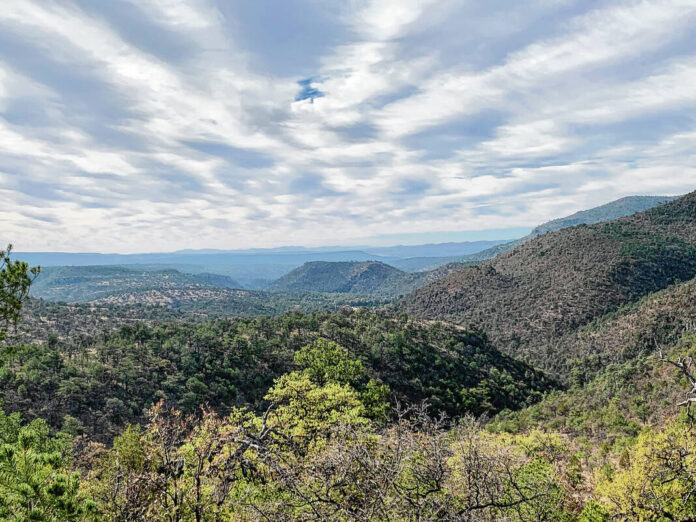In the wilds of rural New Mexico, I sat on a rock outcropping starring into the abyss of a seemingly endless landscape. The mountainous region’s arid climate leaves one wondering how anything could survive here, yet wildlife thrives.
Deer, elk, aoudad, turkey, quail, coyotes and many more species make their home amongst the cactus and scrubby trees. In the future, hopefully a healthy population of Mexican grey wolves will again roam these lands.
Restoration efforts are underway in Arizona and New Mexico to restore Mexican wolf populations. Success is happening through a technique used by the Mexican Wolf Interagency Field Team called cross-fostering. This entails adding wolf pups born in captivity to wild litters. When the captive born pups are 14 or fewer days old, they are placed in a den with wild wolf pups of the same age. The hope is the wild Mexican wolves adopt the introduced pups.
The Mexican wolf recovery efforts are being led by the Arizona Game and Fish Department, New Mexico Department of Game and Fish and the U.S. Fish and Wildlife Service. They recently announced the major milestone of six cross-fostered Mexican wolves maturing to breeding age in the wild. These six wolves add genetic diversity to the recovery of the subspecies. With the addition of these six wolves, there are now 13 cross-fosters surviving in the wild in Arizona and New Mexico. The goal was nine.
“We trounced that number,” said Jim deVos, the Arizona Game and Fish Department’s Mexican wolf recovery coordinator. “The importance of this milestone cannot be overstated, as conserving genetic diversity is one of the major challenges to recovery and delisting of this subspecies.”
Mexican wolves historically roamed throughout the American Southwest and Mexico. Sadly, eradication campaigns nearly wiped them off the face of the Earth. The path to recovery began when they were listed by the U.S. Fish and Wildlife Service as an endangered species in 1976. This likely saved the species from extinction. The recovery program officially began in 1988.
“It is a major milestone that cross-fostering efforts have resulted in this number of genetically valuable Mexican wolves being recruited into the wild population to help both the genetic recovery criteria and the number of wolves in the wild to meet recovery goals,” said Clay Crowder, the assistant director of the Wildlife Management Division. “The Mexican wolf is a subspecies that was nearly lost to the wild, but with careful management as demonstrated by this benchmark, recovery and return to state management is a foreseeable goal. While the Endangered Species Act prescribes the need for recovery, the successful progress on the ground is proof of effective state, federal, and tribal management.”
A lot of science, along with sweat equity, goes into recovering wildlife species. There’s also a lot of good old-fashioned finger crossing and praying for positive results. When success occurs, it sets the course for future success.
“When we started the cross-fostering program seven years ago, we only hoped it would be successful,” said Maggie Dwire, Deputy Mexican Wolf Recovery Coordinator for the U.S. Fish and Wildlife Service. “These milestones are proof that cross-fostering is a valid and viable tool that is contributing to the recovery of the species. We are grateful to all the captive facilities, partners, and field staff who work tirelessly year after year to make cross-fostering a success.”
There is no way to put a price on the value of saving a species. It’s our responsibility to do what we can to preserve fauna and flora native to all landscapes. It takes continued efforts and advancements to be successful. Innovative progress, like cross-fostering, gives us who cherish wildlife hope that we will find ways to save other species in peril.
Today, there are approximately 400 Mexican wolves in captivity at breeding facilities, including the Endangered Wolf Center in Missouri. These are all descendants of seven original wolves captured in the 1970s. With the continued success of these cross-fostering programs, I hope one day to hear the howl of a wild Mexican wolf.
See you down the trail …
Brandon Butler writes a weekly outdoors column for the Daily Journal. For more Driftwood Outdoors, check out the podcast on www.driftwoodoutdoors.com or anywhere podcasts are streamed. Send comments to [email protected].





